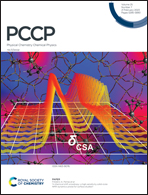Investigation of the anchoring and electrocatalytic properties of pristine and doped borophosphene for Na–S batteries†
Abstract
Designing an anchoring layer on the sulfur electrode has been considered one of the effective approaches to promoting the real application of room-temperature sodium–sulfur (RT-Na–S) batteries. In this work, based on the first-principles calculation method, the potential of pristine and doped borophosphene (BP) as anchoring materials for Na–S batteries has been investigated. The calculated adsorption energies of sodium polysulfides (NaPSs) adsorbed on pristine and doped substrates are higher than those of NaPSs adsorbed with the electrolytes (DOL&DME), indicating that the shuttle effect could be well alleviated. Meanwhile, the projected density of states (PDOS) suggests that the metallic characteristics of the adsorption systems are still well preserved, which is in favor of improving the electronic conductivity. More importantly, excellent electrocatalytic properties of the substrates are exhibited by reducing the catalytic decomposition energy barriers of Na2S, in which 0.27/0.79/1.02 eV is found on the pristine/N-doped/C-doped BP, indicating that the electrochemical processes could be improved smoothly. Therefore, it could be expected that pristine and doped BP are excellent anchoring materials for sodium–sulfur batteries.

- This article is part of the themed collection: 2023 PCCP HOT Articles


 Please wait while we load your content...
Please wait while we load your content...